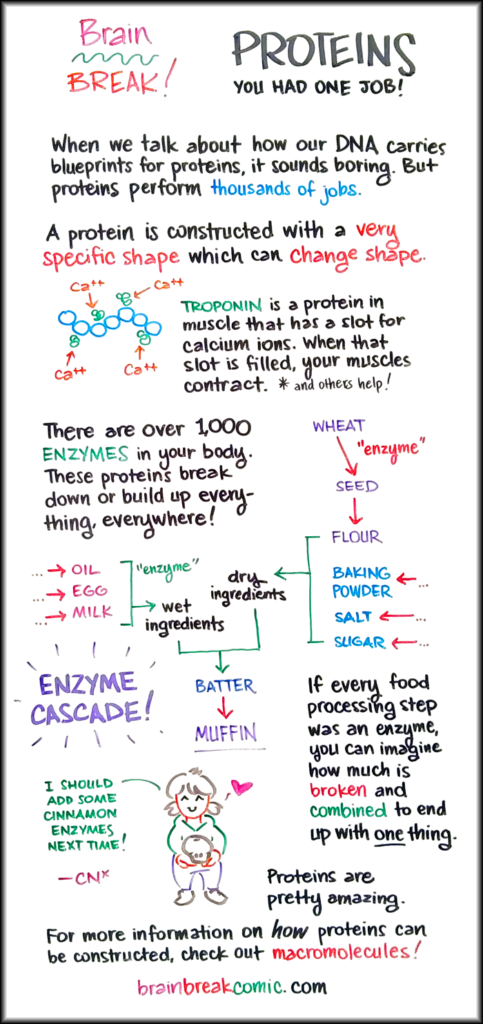
Brain BREAK presents: Proteins.
I’m placing an extra emphasis on enzymes today, but I also like to stress the unique nature of proteins themselves. When we talk about how our DNA carries blueprints for proteins, it’s easy to say, “yeah, ok” and move on to the next flashcard. But proteins perform thousands of jobs. A protein is constructed with a very specific shape, many of which can change shape. I love enzymes, but proteins also make up bones, hair, nails, and more. They’re nothing to shrug at!
For example, troponin is a protein in muscle that has a slot for calcium ions. When that slot is filled, your muscles contract. (Other proteins help!) Its very distinct shape makes this slot, and shape change, possible.
There are over 1,000 enzymes in your body. These proteins break down or build up everything, everywhere! I again stress that a protein is constructed with a very specific shape which can change shape. Whenever I hear that a molecule is a protein, I wonder what job it performs. Enzymes are a perfect example.
Let’s think about baking muffins for a minute. Suppose that every step of making muffins is one enzyme. We’ll start with wheat. You would use one “enzyme” to remove the wheat berry from the chaff. Another enzyme turns these seeds into flour. Meanwhile, baking powder, salt, and sugar have undergone their own series of enzymes to get into your house in a tidy little package. An enzyme (you!) would mix these ingredients to become a huge blend of dry ingredients. Meanwhile, the vegetable oil, egg, and milk have been broken down by enzymes and then built up by an enzyme to become wet ingredients. You, with this action being a separate, very specific enzyme, brings all of these together to become batter. (Maybe you are even lucky enough to have a KitchenAid as an enzyme.) A final enzyme bakes the batter into muffins.
This post brought to you by KitchenAi– just kidding.
This process is what we call an enzyme cascade. Each enzyme interacts with many other enzymes to make products for the body. Perhaps you would use some flour to make pancakes, too, which would be another cascade that branches off of this one. (You’d have to account for the milk and change all the enzymes’ shapes to mix it.) This is why we have so many enzymes! And, missing just one enzyme could halt an entire cascade. A missing gene can cause problems in this way. For example, you might be missing the instructions for the enzyme to process cow’s milk. This causes lactose intolerance. You’d have a bunch of ingredients sitting around on the kitchen counter if the baking powder was missing. You’d never be able to have muffins, ever. (Sad face.)
Proteins are pretty amazing. Remember, when something is a protein, it’s a very complex, enormous molecule with a unique shape. Much of the time, it has just one job. Your DNA carries instructions for making proteins, and don’t shrug off that statement! Proteins are a lot of work to make, and they do a lot of work themselves. If they are damaged, we call that denaturing, and that’s changing shape so that they can no longer do their jobs. Be nice to your proteins. Appreciate them. Is there an International Proteins Day?
For more information on how proteins can be constructed, check out macromolecules!
I should add some cinnamon enzymes next time! -CNx
